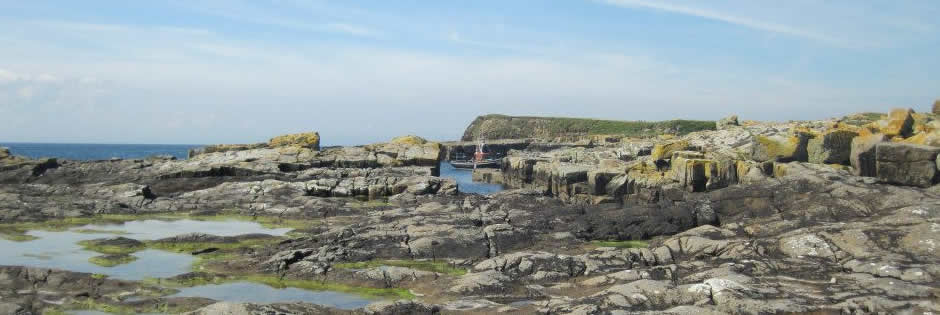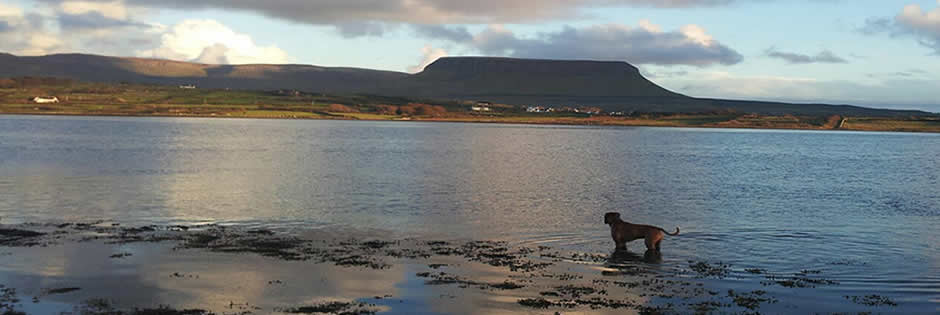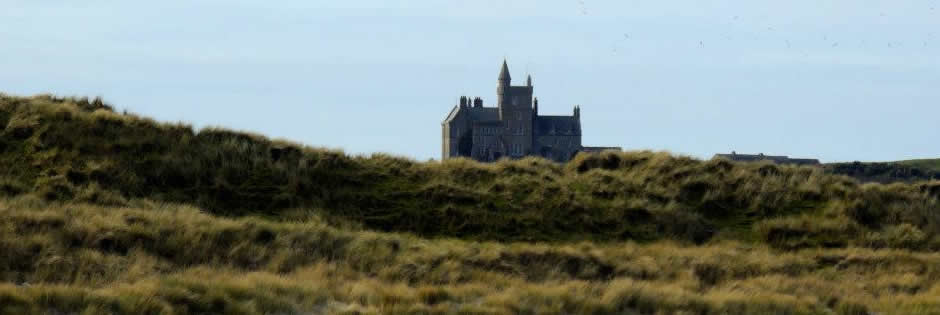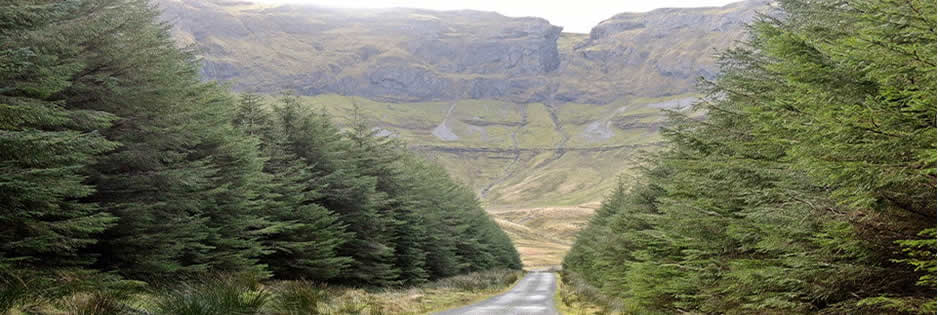For anyone interested in Irish history and heritage, North Sligo has much to offer. Here one can literally trace the dramatic tendrils of our nation, from prehistoric mythology to modern times, in a setting both pristine and majestic. In its lofty mountains, its winding rivers, its jagged coastline, God has created here a land largely unspoiled by time or man.
Leaving Sligo town on the N15 we crest Tully Hill. Suddenly we see the Dartry mountain range spread before us in all its grandeur. The mighty prow of ’bare Benbulben’s head,’ made famous by the poet WB Yeats, defines the landscape here. In the shadow of this unique mountain stretch the rolling hills and valleys of an enchanted land. This is Yeats’ country, a panorama rich in history, folklore and mythology.
In Rathcormac village stands a magnificent bronze memorial to Countess Markievicz. The Countess was born Constance Gore Booth in nearby Lissadell where she spent her early years. An active suffragette she gave her first public speech to promote women’s rights at nearby Drumcliffe. She is best known for the prominent part she played in the Easter Rising of 1916, for which she was sentenced to death, a sentence commuted to life imprisonment solely because of her gender.
Constance took the Dublin seat in the elections of 1918 and became the first woman ever elected to the House of Commons in England. At the formation of the first Irish Dail she was appointed Minister of Labour thus becoming the first woman Cabinet Minister in the world!
Continuing north our next stop is Drumcliffe Visitor’s Centre. Here lies William Butler Yeats, at peace in the Sligo soil that inspired much of his work. But that is very recent history. This was an early Christian site of major significance founded by St. Colmcille in A.D. 575 - the round tower and high cross still remain. St Colmcille is remembered too for his part in the ’ Battle of the Books’: Colmcille copied a book while a guest of St. Finian’s. Finian claimed the copy as well as the book, but Colmcille refused. The dispute was brought to the High King of Ireland whose edict was: ’To every cow its calf and to every book its copy’. In consequence, in 561 AD, the High King and Colmcille engaged in battle on the slopes of Benbulben. Aided by an angel, Colmcille won. Thousands of men were slain and the King forced to concede the copy of the psalter to Colmcille.

Inishmurray Island
Heading northwards once again, rocky cliffs defy the Atlantic gales. Here, the restless ocean tumbles onto miles of rugged shoreline.
Nestled within these waves – just a few miles offshore - lies the mystical island of Innishmurray. St. Molaise founded a Christian Monastery here in the 6th century, the remains of which are remarkably intact. On this island of gale, stone and fire we enter a shadow-land where holy man meets pagan, where Holy Wells calm the sea, where cursing stones and mystic fires consume the heretic. One of its most remarkable features is Leac na Teine, the Stone of the Fire located in Teac na Teine (House of the Fire).
Tradition holds that if all the fires were extinguished on the island, a sod placed on Leac na Teine would ignite spontaneously.

Near the village of Grange, at Streedagh beach three ships of the Spanish Armada were wrecked in 1588. An English official, Geoffrey Fenton, reported: "I numbered in one strand eleven hundred corpses." One of the few Spaniards to escape was Captain Francesco de Cuellar. His diary discovered in 1885 in the archives of the Academia del Historia in Madrid, tells us much of conditions prevailing in Ireland at that time.
Continuing north, Benbulben and the Dartry mountains dominate the landscape. Precipitous limestone slopes plunge to pleasant valleys, farming country, where grazing sheep dot the heights and cattle graze the lowland pastures. Hill walking in unspoiled countryside and hang-gliding with the hawks on capricious up draughts are popular sports here.

Our next stop is Mullaghmore, with its picture postcard harbour, wild sweep of ocean and expanse of golden sand . From the picturesque 19th century stone-built harbour, sit and watch the fishermen at their work while vistas of the scenic Dartry mountains delight your eyes. A cruise to the ancient monastic island of Inishmurray, only an hour’s sail away, is available from here. Another time, another world!
Do stop here and explore, and take the scenic drive around the headland. You won’t be sorry, it is such a pretty road!

Nearby, the fairytale Classiebawn Castle dominates the landscape, built in the mid-19th century by Lord Palmerston. In recent times Lord Louis Mountbatten, great grandson of Queen Victoria, Earl of Burma, last Viceroy of India and Supreme Allied Commander in SE Asia during WW2 succeeded to ownership of the castle and estate. In August 1979 his boat was blown up by the I.R.A. off the coast of Mullaghmore. Lord Mountbatten, his grandson Nicholas, Lady Brabourne and Paul Maxwell died. Hard under Classiebawn, by an outcrop of rock called Dostann na Briona, the fairies, remnant of the dispossessed race of Tuatha de Dannan, reside. At the door of the fort the ’Daoine Mhaith’ come and go in their revelries and travels. The worldly wise may mock at such foolish beliefs but Edwina Ashley, wife of Lord Mountbatten, did not. She often visited and left messages at this enchanted place. Within living memory offerings of poteen were left here in thanksgiving or supplication. Old people know the door where the Sidhe come and go, but the ’Fairy Rock’ is silent and enigmatic, guarding its secrets.
Mullaghmore’s rugged seacoast supported a lifestyle now gone. In less prosperous times these rocks and inlets were seaside gardens, where sea foods, edible seaweeds and fish could be found in abundance.
‘The purple heather is the cloak,
God gave the bogland brown
But man has made a pall of smoke
To hide the distant town.’
Let us head for those peat bogs and heather-cloaked mountains, stopping first to marvel at Creevykeel Court Tomb. Dating from the late Stone Age it was the focal point for early settlers in this countryside, a place of ceremony and worship fulfilling most of the functions of the Christian churches of today. Excavated ashes and bone fragments that have been discovered indicate burials and cremations, ceremonial rites of passage we still perform today.

As we enter the Gleniff Horseshoe, we see on our left the remains of an old barytes mill. Used in the manufacture of glass, paints, china, wallpaper and pre-Xray barium meals, barytes was mined here until the middle of the 20th century. In 1928 a railroad ran from here to Mullaghmore, built to ship the product out through Mullaghmore harbour. Gleniff’s industrial past is long gone and now the hills are a haven of peace and quiet.
Driving around the horseshoe our eyes are drawn to an arched cave 1,200 feet up the mountain. This is said to be the last hiding place of Diarmuid and Grainne, in their perpetual flight from Fionn mac Cumhaill leader of the warrior Fianna. Grainne, daughter of the High King Cormac Mac Airt, was married to Fionn at Tara in County Meath. At the wedding feast the fickle Grainne fell in love with the younger warrior Diarmuid, and persuaded him to elope with her. Next day, the vengeful Fionn set out in pursuit of his former comrade in arms and his faithless bride. Fionn’s pursuit was relentless but the hunted couple eluded their pursuers for many years. The ruins of an old schoolhouse along the ring road stand as testament to this once populous valley. Turf is still cut here, but compared with times when this was the only fuel used in country homes for heating and cooking, very little is saved today.
Leaving the Gleniff valley we turn left along the mountain road towards Sligo, into the Derelehan hinterland. Have your camera ready, as the views of Ben Wiskin and Benbulben are spectacular at this close range.

It was here, on the slopes of Benbulben that Diarmuid met his end. While sleeping in the Gleniff cave, the couple were awakened by the baying of hounds hunting boar on the slopes of Benbulben. Next day, word came that the boar was slaughtering Fionn and the Fianna. Grainne begged him not to go, reminding him of the prophecy that he would meet his death by the great boar of Benbulben. Despite her entreaties, Diarmuid’s warrior instinct prevailed and he went out to meet his fate, killing the animal but being mortally wounded. Fionn, coming on Diarmuid in the pangs of death, felt sorry for him but would not save his unfaithful comrade, and thus ended his fabled pursuit of the lovers.
Our brief tour of North Sligo is over. Let us hope that this sweep of beautiful countryside may long remain unspoiled, and that the words of one English visitor a hundred years ago will be as valid tomorrow as they were then: ‘The charm of the place lies in its simplicity and the tranquil delight of doing nothing if one so chooses.
For information on the North Sligo Tour please contact the Benwiskin Centre.
Joe McGowan has written several books. They are available in bookshops or on www.sligoheritage.com/